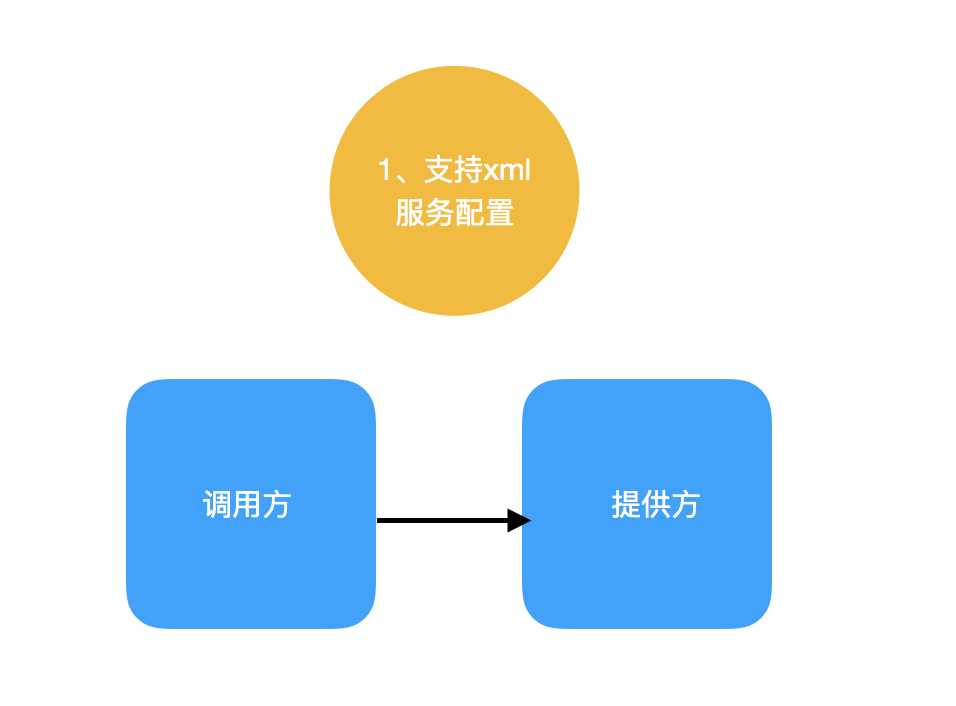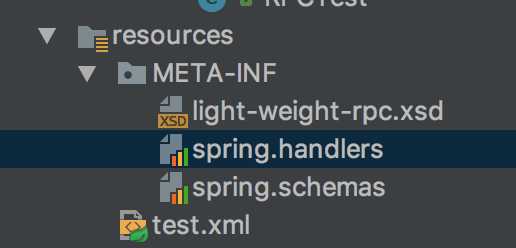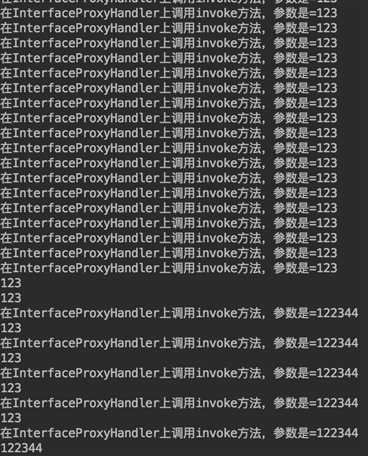标签:存在 mil war 轮询 pool 标签 sse getc 参数
之前在前一篇的《Netty自娱自乐之协议栈设计》,菜鸟我已经自娱自乐了设计协议栈,gitHub地址为https://github.com/vOoT/ncustomer-protocal。先这一篇中,准备接着自娱去实现一个RPC框架,现在公司共的是Dubbo,那么先不看其代码,先自行实现一下吧。
dubbo 包括 注册和服务调用,细节我们先不管,然后,我先先实现一个如下的简单模型

哈哈哈,第一个版本就是这么简单,粗暴。说到自定义配置,首先想到的是Spring 自定义标签,利用标签进行配置服务。而我设计的标签页非常的简单,使用如下:
<rpc:provider id="helloServiceImpl" class="com.qee.rpc.HelloServiceImpl"/>
<rpc:cumsumer id="helloService" interface="com.qee.rpc.HelloService"/>
看到了没,非常像dubbo,那么如何实现一个自定义标签呢,从网上可以了解搜索的到,现在我就简单说明一下,如何编写和测试自己自定义的Spring 标签。
一、 定义xsd 文件,该文件是xml文件的 schema 定义。从上面的例子中,我们知道xsd文件里面应该有2个节点,1个provider节点和1个cumsumer节点定义。然后制定provider节点有id 和classs属性,而cumsumer节点有 id和 interface属性。定义文件如下(该文件名为light-weight-rpc.xsd):
<?xml version="1.0" encoding="UTF-8"?> <xsd:schema xmlns="http://www.qee.com/schema/rpc" xmlns:xsd="http://www.w3.org/2001/XMLSchema" xmlns:beans="http://www.springframework.org/schema/beans" targetNamespace="http://www.qee.com/schema/rpc" elementFormDefault="qualified" attributeFormDefault="unqualified"> <xsd:import namespace="http://www.springframework.org/schema/beans"/> <xsd:element name="provider" type="rpc-provider-type"></xsd:element> <xsd:element name="cumsumer" type="rpc-cumsumer-type"></xsd:element> <xsd:complexType name="rpc-provider-type"> <xsd:attribute name="id" type="xsd:string" use="required"></xsd:attribute> <xsd:attribute name="class" type="xsd:string" use="required"></xsd:attribute> </xsd:complexType> <xsd:complexType name="rpc-cumsumer-type"> <xsd:attribute name="id" type="xsd:string" use="required"></xsd:attribute> <xsd:attribute name="interface" type="xsd:string" use="required"></xsd:attribute> </xsd:complexType> </xsd:schema>
上面,画上红线的地方需要注意和主要的关注点,首先需要说明这个文件的name space 为 xmlns="http://www.qee.com/schema/rpc 。其他的具体如何写可以到网上搜索。有了这个文件,我们需要在xml的文件引入他,比如如下test.xml文件如何引用该文件
<?xml version="1.0" encoding="UTF-8"?> <beans xmlns="http://www.springframework.org/schema/beans" xmlns:xsi="http://www.w3.org/2001/XMLSchema-instance"
xmlns:rpc="http://www.qee.com/schema/rpc" xsi:schemaLocation="http://www.springframework.org/schema/beans http://www.springframework.org/schema/beans/spring-beans.xsd http://www.qee.com/schema/rpc http://www.qee.com/schema/rpc/light-weight-rpc.xsd"> <rpc:provider id="helloServiceImpl" class="com.qee.rpc.HelloServiceImpl"/> <rpc:cumsumer id="helloService" interface="com.qee.rpc.HelloService"/> </beans>
上面就是一个spring xml 文件,主要关注的是花黄线的部分,这样就可以使用<rpc:provider> 和<rpc:cumsumer>。
二、组织文件,即要把文件放到合适的地方,让Spring能够识别。第一步,需要把light-weight-rpc.xsd文件放到META-INF的文件夹下,然后在META-INF文件创建2个新的文件,名字固定。
文件1:spring.schemes ,该文件里面直有一行数据,如下
http\://www.qee.com/schema/rpc/light-weight-rpc.xsd=META-INF/light-weight-rpc.xsd
该行告诉Spring容器,http://www.qee.com/schema/rpc/light-weight-rpc.xsd ,之前定义命名空间的light-weight-rpc.xsd文件是META-INF下的light-weight-rpc.xsd
文件2:spring.handlers,该文件里面也只有一行数据,如下
http\://www.qee.com/schema/rpc=com.qee.rpc.config.support.LightWeightRpcNamespaceHandlerSupport
该行告诉Spring容器,命名空间http://www.qee.com/schema/rpc的解析处理器是 com.qee.rpc.config.support.LightWeightRpcNamespaceHandlerSupport。这个例子的目录如下

好了到现在我们基本把文件的位置放置正确了。之后就是需要编写com.qee.rpc.config.support.LightWeightRpcNamespaceHandlerSupport。
三、编写com.qee.rpc.config.support.LightWeightRpcNamespaceHandlerSupport,该类需要继承NamespaceHandlerSupport,重写init()方法。主要的目的就是注册,节点解析处理器。
代码如下:
public class LightWeightRpcNamespaceHandlerSupport extends NamespaceHandlerSupport { @Override public void init() { //注册用于解析<rpc>的解析器 registerBeanDefinitionParser("provider", new LightWeightRpcBeanDefinitionParser()); registerBeanDefinitionParser("cumsumer", new LightWeightRpcBeanDefinitionParser()); } }
从代码上我们只要,就是把解析xml文件provider和cumsumer节点进行BeanDefinition转化解析。
因为这2个节点非常的类型。所以我就只想用痛一个解析处理器,LightWeightRpcBeanDefinitionParser,该转化器继承org.springframework.beans.factory.xml.AbstractSingleBeanDefinitionParser。具体代码如下:
public class LightWeightRpcBeanDefinitionParser extends AbstractSingleBeanDefinitionParser { protected Class getBeanClass(Element element) { return LightWeightRPCElement.class; } protected void doParse(Element element, BeanDefinitionBuilder bean) { String interfaces = element.getAttribute("interface"); String clazz = element.getAttribute("class"); String id = element.getAttribute("id"); bean.addPropertyValue("id", id + "Config"); if (StringUtils.hasText(id)) { bean.addPropertyValue("beanName", id); } if (StringUtils.hasText(clazz)) { bean.addPropertyValue("clazz", clazz); } if (StringUtils.hasText(interfaces)) { bean.addPropertyValue("interfaces", interfaces); } } }
我们把xml的id 放到 bean 的beanName,把id+"Config"放到 id上,因为这个 BeanDefinitionBuilder 最终生成的对象是 LightWeightRPCElement,不是我们需要的代码对象。
@Data @ToString public class LightWeightRPCElement {
private String id;
private String beanName;
private String clazz;
private String interfaces;
}
是不是非常的简单,到目前为止,我们已经完成了所有的自定义标签工作,下一步当然就是测试一下啦,代码如下:
public class RPCTest { public static void main(String[] args) { ApplicationContext ctx = new ClassPathXmlApplicationContext("test.xml"); LightWeightRPCElement p1= (LightWeightRPCElement)ctx.getBean("helloServiceImplConfig"); LightWeightRPCElement p2= (LightWeightRPCElement)ctx.getBean("helloServiceConfig"); System.out.println(p1); System.out.println(p2); } }
执行结果是:

四、这一步的话,我们需要处理之前已经注册到Spring的 LightWeightRPCElement 的对象,在上面的例子中,这两个的Bean Id分别是helloServiceImplConfig、helloServiceConfig,之后我们需要通过这2个对象来产生我们需要代理对象。首先我们来看一下JDK的生成代理对象的方法:
public static Object newProxyInstance(ClassLoader loader, Class<?>[] interfaces,InvocationHandler invocationHandler);
从上面的代码中,我们知道生产一个代理对象需要一个类加载器loader,和代理接口的字节码interfaces,和代理处理具柄invocationHandler。那么我程序定义了一个名为InterfaceProxyHandler的代理处理具柄,它继承InvocationHandler。代码如下:
@Data public class InterfaceProxyHandler implements InvocationHandler { private CallBackExcuteHandler excuteHandler; public InterfaceProxyHandler(CallBackExcuteHandler excuteHandler) { this.excuteHandler = excuteHandler; } @Override public Object invoke(Object proxy, Method method, Object[] args) throws Throwable { MessageCallback callback = ExcuteManager.invoke(excuteHandler); .......//这里代码还没写,其实就是处理返回结果,准备下章解决。 } }
从上面的代码,我们知道,它具体的执行逻辑是invoke方法。具体内容就是通过一个ExcuteManager来处理逻辑,该ExcuteManager就是一个封装了ExecutorService的线程池管理类。其意思是每个代理对象去执行方法时,都是通过线程池的一个线程去执行,而这个线程池管理类的执行方法invoke需要一个Callable任务,所以程序自定义了一个CallBackExcuteHandler类。代码如下:
public class CallBackExcuteHandler implements Callable<MessageCallback> { private String beanName; private List<InetSocketAddress> remoteAddresses; private LoadBalancedStrategy loadBalancedStrategy; public CallBackExcuteHandler(String beanName) { this.beanName = beanName; } public CallBackExcuteHandler(String beanName, List<InetSocketAddress> remoteAddresses) { this.beanName = beanName; this.remoteAddresses = remoteAddresses; } public CallBackExcuteHandler(String beanName, List<InetSocketAddress> remoteAddresses, LoadBalancedStrategy loadBalancedStrategy) { this.beanName = beanName; this.remoteAddresses = remoteAddresses; this.loadBalancedStrategy = loadBalancedStrategy; } public CallBackExcuteHandler() { } /** * 线程执行 * * @return * @throws Exception */ @Override public MessageCallback call() throws Exception { if (CollectionUtils.isEmpty(remoteAddresses)) { List<ServiceAddressConfig> remoteUrls = ServiceRemoteUrlContext.getInstance().getRemoteUrls(beanName); if (CollectionUtils.isEmpty(remoteUrls)) { throw new RuntimeException("服务 [" + beanName + " ]远程地址错误"); } } int size = remoteAddresses.size(); int idx = loadBalancedStrategy.strategy(size); InetSocketAddress inetSocketAddress = remoteAddresses.get(idx); System.out.println("返回的地址" + inetSocketAddress + " idx=" + idx); MessageCallback messageCallback = new MessageCallback(); return messageCallback; } }
具体逻辑就是看call,这里就是处理的具体逻辑,这个逻辑其实就是处理Netty网络通信的内容,等下章开始讲解,这一章主要通过搭建具体的框架,之后补充细节。这里远程地址为空的话,去远程地址管理上下文获取,接着通过一个负载均衡策略对象,返回其中一个地址的index。通过这种方式实现负载均衡调用。
远程地址管理上下文对象代码如下:
public class ServiceRemoteUrlContext { private Map<String, List<ServiceAddressConfig>> remoteUrls; private volatile static ServiceRemoteUrlContext context; private ServiceRemoteUrlContext() { } public static ServiceRemoteUrlContext getInstance() { if (context == null) { synchronized (ServiceRemoteUrlContext.class) { if (context == null) { context = new ServiceRemoteUrlContext(); context.remoteUrls = new HashMap<>(); } } } return context; } /** * 添加一个远程地址,地址从service-url.properties 获取 * * @param beanName * @param serviceAddressConfig * @return */ public boolean addServiceAddress(String beanName, ServiceAddressConfig serviceAddressConfig) { if (StringUtils.isEmpty(beanName) || serviceAddressConfig == null) { return false; } synchronized (remoteUrls) { if (remoteUrls.get(beanName) == null) { List<ServiceAddressConfig> remoteAddress = new ArrayList<>(); remoteAddress.add(serviceAddressConfig); remoteUrls.put(beanName, remoteAddress); } else { List<ServiceAddressConfig> serviceAddressConfigs = remoteUrls.get(beanName); if (serviceAddressConfigs.contains(serviceAddressConfig)) { return false; } serviceAddressConfigs.add(serviceAddressConfig); return true; } } return false; } /** * 获取一个服务的远程地址 ,beanName like "com.qee.rpc.config.test.HelloService" * * @param beanName * @return */ public List<ServiceAddressConfig> getRemoteUrls(String beanName) { return remoteUrls.get(beanName); } }
负载均衡的接口,代码如下:
public interface LoadBalancedStrategy { /** * 从 0 -size-1 获取一个值 * * @param size * @return */ int strategy(int size); }
现在只实现了1中,轮询方法,之后可以写成可配置,代码如下:
public class RollPolingStrategy implements LoadBalancedStrategy { private int currentValue = 0; private Class<?> clazz; public RollPolingStrategy(Class<?> clazz) { this.clazz = clazz; } @Override public int strategy(int size) { synchronized (clazz) { int nextValue = (currentValue + 1) % size; currentValue = nextValue; if (currentValue > size) { nextValue = 0; } return currentValue; } } }
接着,我们需要看一下简单的ExcuteManager类,代码如下:
public class ExcuteManager { /** * 默认是200个线程 */ private static final int DEFAULT_THRED_NUM = 200; /** * 超时时间为1秒 */ private static final int DEFAULT_TIME_OUT_TIME = 1000; private static ExecutorService executorService = Executors.newFixedThreadPool(DEFAULT_THRED_NUM); public static MessageCallback invoke(Callable<MessageCallback> call) { Future<MessageCallback> submit = executorService.submit(call); try { return submit.get(DEFAULT_TIME_OUT_TIME, TimeUnit.MILLISECONDS); } catch (InterruptedException e) { submit.cancel(true); throw new RuntimeException("the method is interupted ", e); } catch (ExecutionException e) { submit.cancel(true); throw new RuntimeException("the method cal excute exception", e); } catch (TimeoutException e) { System.out.println(Thread.currentThread().getName()); submit.cancel(true); throw new RuntimeException("the method call is time out ", e); } } public static void shutdown() { executorService.shutdown(); } public static void shutdownNow() { executorService.shutdownNow(); } }
这些参数,在后面都做成可配置的。
最后一步了,就是需要生产一个代理对象,并把代理对象注册到Spring容器里面。那么Spring的 BeanPostProcessor可以为我们解决问题,看代码如下:
@Component public class RegisterRpcProxyBeanProcessor implements BeanPostProcessor, BeanFactoryAware { private BeanFactory beanFactory; @Override public Object postProcessBeforeInitialization(Object bean, String beanName) throws BeansException { return bean; } @Override public Object postProcessAfterInitialization(Object bean, String beanName) throws BeansException { Object target = bean; if (bean instanceof LightWeightRPCElement) { //如果是LightWeightRPCElement,则强转,否则不处理 LightWeightRPCElement rpcElement = (LightWeightRPCElement) bean; // 接着就是获取 之前XML 的属性值 Class<?> clazz = null; if (!StringUtils.isEmpty(rpcElement.getInterfaces())) { try { clazz = Class.forName(rpcElement.getInterfaces()); } catch (ClassNotFoundException e) { throw new RuntimeException("获取 [" + rpcElement.getInterfaces() + " ] class字节码失败"); } } //通过ServiceRemoteUrlContext得到这个接口的远程端口和地址 List<ServiceAddressConfig> remoteUrls = ServiceRemoteUrlContext.getInstance().getRemoteUrls(rpcElement.getInterfaces()); List<InetSocketAddress> remoteAddressList = ExtractUtil.extractList(remoteUrls, "remoteAddress", ServiceAddressConfig.class); CallBackExcuteHandler callBackExcuteHandler = new CallBackExcuteHandler(rpcElement.getInterfaces(), remoteAddressList,new RollPolingStrategy(clazz)); InterfaceProxyHandler interfaceProxyHandler = new InterfaceProxyHandler(callBackExcuteHandler); //这里之后可以优化为各种方式产生动态代理,如cglib等 target = Proxy.newProxyInstance(bean.getClass().getClassLoader(), new Class[]{clazz}, interfaceProxyHandler); if (beanFactory instanceof DefaultListableBeanFactory) { //这里就是动态注册对象,把动态代理对象注册到Spring上 DefaultListableBeanFactory defaultFactory = (DefaultListableBeanFactory) beanFactory; defaultFactory.registerSingleton(rpcElement.getBeanName(), target); } } return target; } @Override public void setBeanFactory(BeanFactory beanFactory) throws BeansException { this.beanFactory = beanFactory; }
从上面的注释大家应该也非常的清楚了,现在只剩下最后一步了,如何获取该接口的远程服务地址和端口,dubbo是通过注册中心zookeeper,而这里的简单的采用配置,例子如下:
com.qee.rpc.config.test.HelloService 127.0.0.1:8888,127.0.0.1:7777,127.0.0.1:9999
对,就是在一个properties文件上 通过服务接口全称 和指定远程服务主机和端口。之后可以改为有注册中心的方式。现在我们来看一下读取这个配置的类,代码如下:
@Component public class ServiceRemoteUrlsInit implements InitializingBean { /** * 远程服务配置地址路径,默认 */ @Value("${remote-urls-path:classpath:service-urls.properties}") private String remoteUrlsPropertyPath; @Override public void afterPropertiesSet() throws Exception { Properties pps = new Properties(); if (!remoteUrlsPropertyPath.startsWith("classpath")) { throw new RuntimeException(remoteUrlsPropertyPath + "不存在"); } String[] filePath = remoteUrlsPropertyPath.split(":"); if (filePath == null || filePath.length != 2) { throw new RuntimeException(remoteUrlsPropertyPath + "内容配置错误"); } ClassPathResource resource = new ClassPathResource(filePath[1]); InputStream in = new BufferedInputStream(resource.getInputStream()); pps.load(in); Enumeration en = pps.propertyNames(); while (en.hasMoreElements()) { String beanName = (String) en.nextElement(); String strRemoteUrls = pps.getProperty(beanName); String[] remoteUrls = strRemoteUrls.split(","); if (remoteUrls == null || remoteUrls.length == 0) { break; } for (String remoteUrl : remoteUrls) { String[] hostPort = remoteUrl.split(":"); if (hostPort == null || hostPort.length != 2) { throw new RuntimeException(remoteUrlsPropertyPath + " 配置内容错误"); } ServiceAddressConfig serviceAddressConfig = new ServiceAddressConfig(); serviceAddressConfig.setBeanName(beanName); serviceAddressConfig.setHostName(hostPort[0]); serviceAddressConfig.setRemotePort(Integer.valueOf(hostPort[1])); InetSocketAddress socketAddress = new InetSocketAddress(serviceAddressConfig.getHostName(), serviceAddressConfig.getRemotePort()); serviceAddressConfig.setRemoteAddress(socketAddress); ServiceRemoteUrlContext.getInstance().addServiceAddress(beanName, serviceAddressConfig); } } } }
代码比较简单,就是实现 InitializingBean这个Spring接口,Spring启动在Bean创建后,初始化 afterPropertiesSet()这个配置,在这个方法里面读取类路径的配置文件。最后我们来运行一个例子。还是HelloService.我们有一个Invoker类,需要注入HelloService 对象调用。代码如下:
@Component public class Invoker { @Autowired private HelloService helloService; @Resource(name = "helloService") private HelloService helloService2; public void print() { helloService.hello("123"); helloService2.hello("122344"); } }
然后通过SpringBoot 启动测试:
@ComponentScan(basePackages = "com.qee.rpc") @EnableAutoConfiguration public class App { private static ExecutorService executorService = Executors.newCachedThreadPool(); private static final CountDownLatch cd = new CountDownLatch(1); public static void main(String[] args) { try { SpringApplication.run(App.class, args); System.out.println("the main Thread :" + Thread.currentThread().getName()); final Invoker invoker = (Invoker) ApplicationContextUtils.getBean("invoker"); for (int i = 0; i < 300; i++) { executorService.execute(new Runnable() { @Override public void run() { try { cd.await(); } catch (InterruptedException e) { e.printStackTrace(); } invoker.print(); } }); } cd.countDown(); Thread.sleep(100000); } catch (InterruptedException e) { e.printStackTrace(); } finally { ExcuteManager.shutdown(); executorService.shutdown(); } }
有300个线程去调这个 invoker.print();修改一下 InterfaceProxyHandler的invoke方法,因为我们底层的通信还没完成。所以以
System.out.println("在InterfaceProxyHandler上调用invoke方法,参数是=" + args[0]);
以这个语句来测试一下代码,其中这个大致框架已经上传到gitHub:https://github.com/vOoT/light-weight-rpc, 有什么建议和问题,大家一起讨论吧。最后贴一下执行结果:

哈哈哈,这样我们是不是就是可以通过Spring注解 @Autowired 和 @Resource 来注入动态对象。
Netty自娱自乐之类Dubbo RPC 框架设计构想 【上篇】
标签:存在 mil war 轮询 pool 标签 sse getc 参数
原文地址:http://www.cnblogs.com/liferecord/p/7511617.html